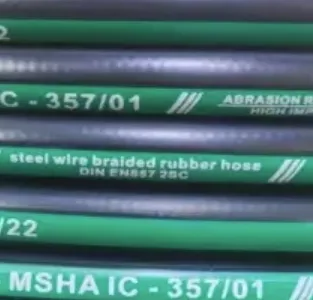335345435
Aug . 07, 2025 10:51 Back to list
Hydraulic Hose Pipe: Types, Pricing, and How to Source the Right One
Hydraulic systems are everywhere—from construction machinery and agricultural equipment to industrial plants and heavy-duty transportation. At the heart of these systems lies the hydraulic hose pipe, a critical component that transfers high-pressure fluids safely and efficiently.
Whether you’re maintaining excavators, setting up a new production line, or searching for bulk hydraulic hose for sale, it’s essential to understand hydraulic hose types, pressure ratings, applications, and how hydraulic hose prices vary based on these factors.

What Is a Hydraulic Hose?
A hydraulic hose is a reinforced flexible pipe designed to carry hydraulic fluid under high pressure in a sealed and durable form. It's built to withstand harsh environments, extreme pressure, and demanding mechanical movement while ensuring fluid transfer with minimal energy loss.
Hydraulic hoses are typically made from:
Synthetic rubber or thermoplastic inner tubes (resist hydraulic oil)
Reinforced layers (braided or spiral-wrapped steel wire or textile)
Outer covers (abrasion-, UV-, and weather-resistant)
These hoses are essential for mobile and stationary hydraulic systems in:
Excavators, loaders, and tractors
CNC machines and factory presses
Forklifts and cranes
Marine hydraulics
Mining and oil & gas applications
Common Hydraulic Hose Types
Understanding hydraulic hose type is critical for matching system requirements. The most common classifications follow the SAE and EN (DIN) standards:
1. SAE 100R1
Single-wire braided
Medium pressure
Used in construction and agricultural equipment
2. SAE 100R2
Double-wire braided
Higher pressure than R1
Common in mining, industrial machinery
3. SAE 100R3
Textile braid reinforcement
Lower pressure, flexible
Often used for return lines or hydraulic circuits in tight spaces
4. SAE 100R4
Suction and return hose
Wire helix for vacuum support
Used in tank suction lines or low-pressure oil movement
5. SAE 100R12 / R13 / R15
Four- or six-spiral wire wrap
Ultra-high pressure
Used in heavy-duty hydraulic systems like injection molding machines or rock drills
6. Thermoplastic Hoses (SAE 100R7 / R8)
Non-conductive, lightweight
For mobile equipment and aerial platforms
Each hydraulic hose pipe is rated for pressure, temperature, flexibility, and fluid compatibility—so choosing the wrong type could result in leaks, system failure, or safety hazards.
Hydraulic Hose Prices: What Affects Cost?
Hydraulic hose prices can vary significantly depending on:
|
Factor |
Description |
|
Hose type & spec |
Higher-pressure hoses (e.g. R12, R13) cost more |
|
Size (ID) |
Larger inner diameters (e.g. 3/4", 1", 1-1/2") raise cost |
|
Length |
Custom or long-length hoses cost more |
|
Reinforcement |
Braided (cheaper) vs. spiral (more durable) |
|
Outer cover |
Extra abrasion-resistant or weatherproof layers add price |
|
Brand |
Reputable brands (e.g., Gates, Parker, Manuli) charge more |
|
End fittings |
Crimped ends or stainless fittings increase price |
Estimated Hydraulic Hose Price Range (2025, USD):
|
Hose Type |
Size |
Price (USD/meter) |
|
SAE 100R1 |
1/4" |
$2.50 – $4.00 |
|
SAE 100R2 |
3/8" |
$3.50 – $6.00 |
|
SAE 100R12 |
1/2" |
$6.00 – $10.00 |
|
SAE 100R13 |
3/4" |
$8.00 – $15.00 |
|
SAE R7 (Thermoplastic) |
1/4" |
$3.00 – $5.00 |
Bulk purchases (coils of 50m, 100m, or full reels) and OEM orders can significantly reduce per-meter pricing by 20–30%.
Where to Buy Hydraulic Hose for Sale
If you’re looking for hydraulic hose for sale, consider these sourcing options:
1. Industrial Distributors & Hose Shops
Ready-to-use hoses with fittings
Quick turnaround for urgent repairs
2. Online Marketplaces
Huge selection from global suppliers
Good for sourcing hydraulic hose pipe in bulk or private label
3. OEM Hose Manufacturers
For buyers who need high volume or custom specs
Private branding, custom printing, and flexible logistics
Ideal for machinery OEMs, resellers, or fleet operators
Tips for Choosing the Right Hydraulic Hose Pipe
Check pressure ratings – PSI must match or exceed your system’s operating pressure.
Use the STAMPED method: Size, Temperature, Application, Material, Pressure, Ends, Delivery.
Verify bend radius – Especially important in tight installations.
Look for certifications – SAE, ISO, or EN/DIN standards ensure quality and safety.
Ask about hose lifespan – Some brands offer longer resistance to ozone, abrasion, or UV.
Also, don’t overlook fittings—using mismatched or low-quality couplings can lead to serious failures even if the hose is top-grade.
Hydraulic Hose FAQs
Q1: Can I use any hydraulic hose with any fluid?
A: No. Compatibility depends on hose inner tube material. Always check with the manufacturer for compatibility with hydraulic oil, water-glycol, or synthetic fluids.
Q2: What’s the difference between braided and spiral hoses?
A: Braided hoses use one or two layers of wire braid; spiral hoses use multiple wire spirals. Spiral hoses handle much higher pressure and are used in extreme-duty applications.
Q3: How long should a hydraulic hose last?
A: With proper installation and use, braided hoses may last 2–5 years; spiral hoses can last longer. Regular inspection and replacement schedules are essential.
Q4: Can I crimp fittings myself?
A: Yes, if you have the correct crimping machine, dies, and specs. Otherwise, get pre-assembled hoses from certified hose shops or suppliers.
Q5: Where can I get hydraulic hoses in bulk for resale?
A: Contact OEM hose manufacturers or large distributors. Many offer full reels or pallet orders with private label options.
-
LPG Hose: Choosing the Right Hose for Safe, Reliable Gas Transfer
NewsAug.07,2025
-
Industrial Hose: Types, Applications, and Where to Find Reliable Suppliers
NewsAug.07,2025
-
Hydraulic Hose Pipe: Types, Pricing, and How to Source the Right One
NewsAug.07,2025
-
Hydraulic Fittings: Types, Customization, and Where to Source Them
NewsAug.07,2025
-
High Pressure Washer Hoses: Buying Guide, Specs, and Supplier Insights
NewsAug.07,2025
-
Choosing the Right Gasoline Hose: Flexibility, Resistance, and Supply Options
NewsAug.07,2025



